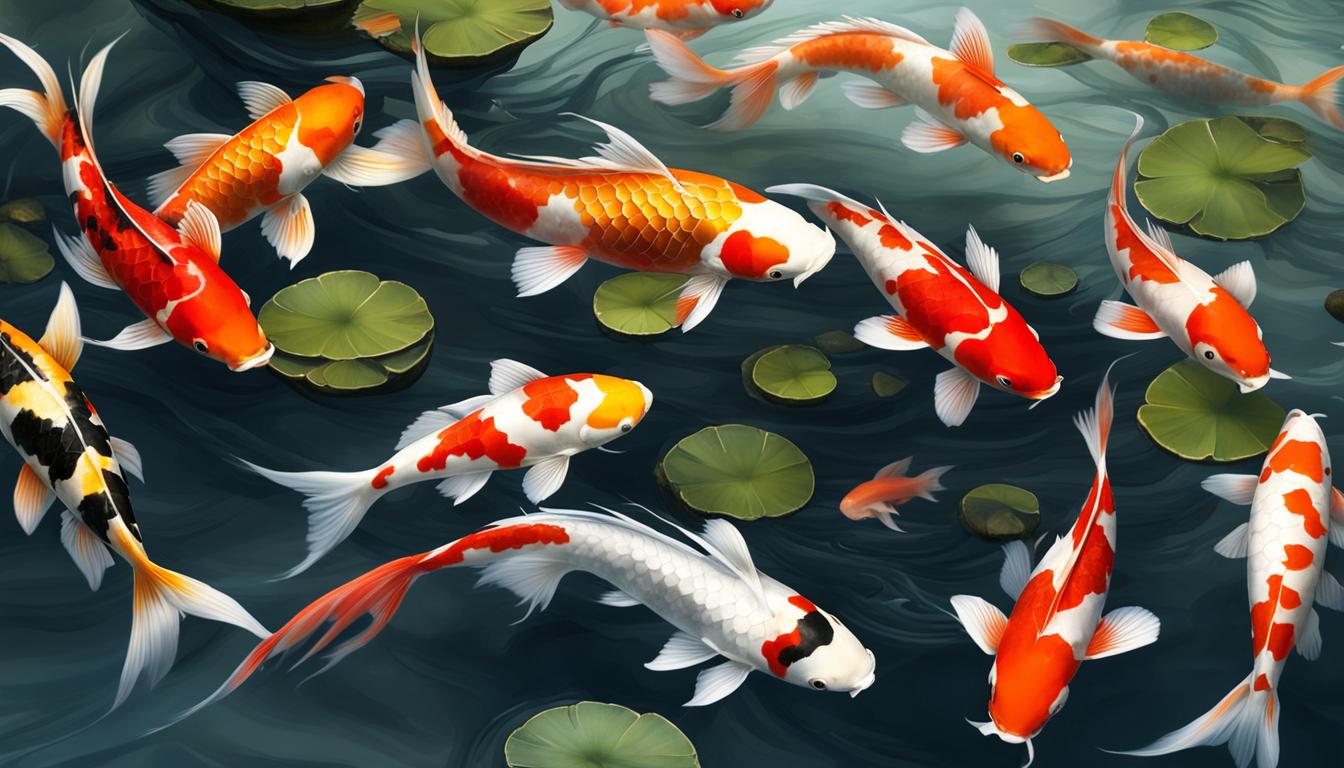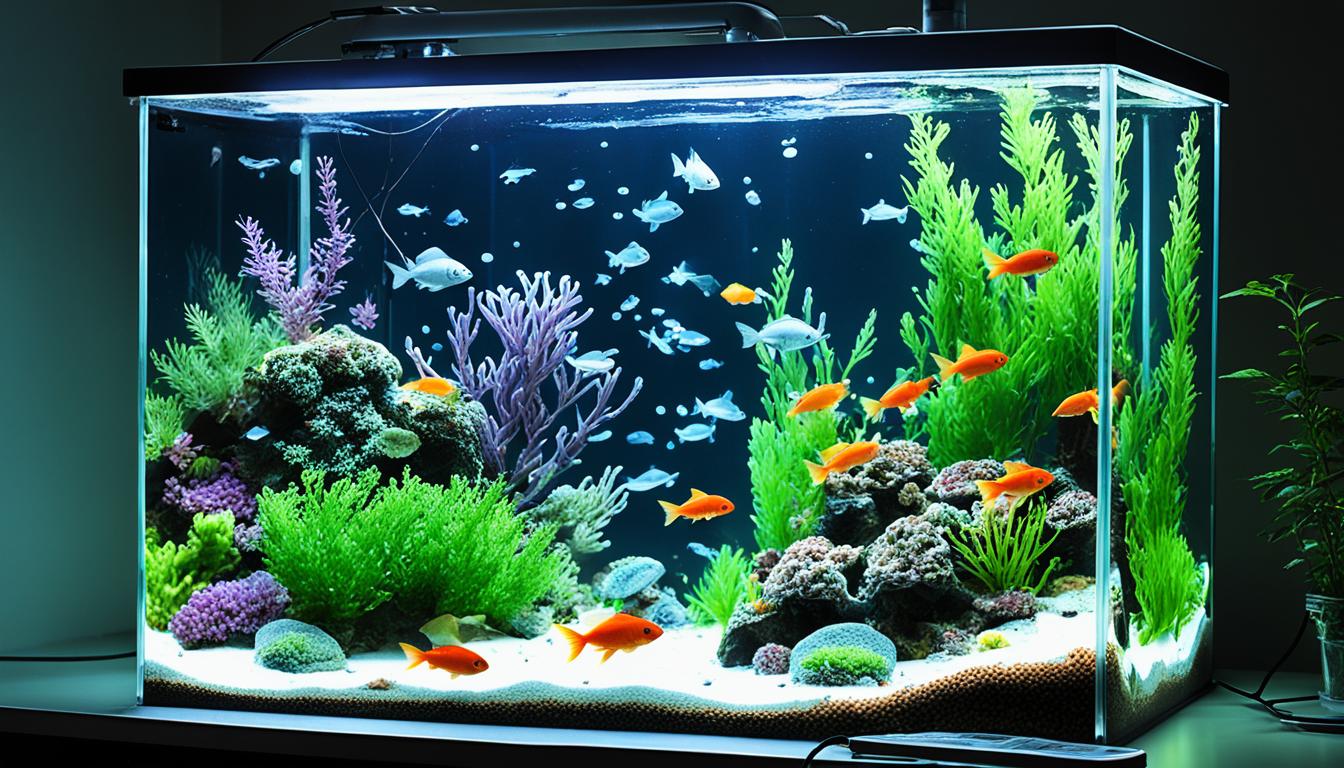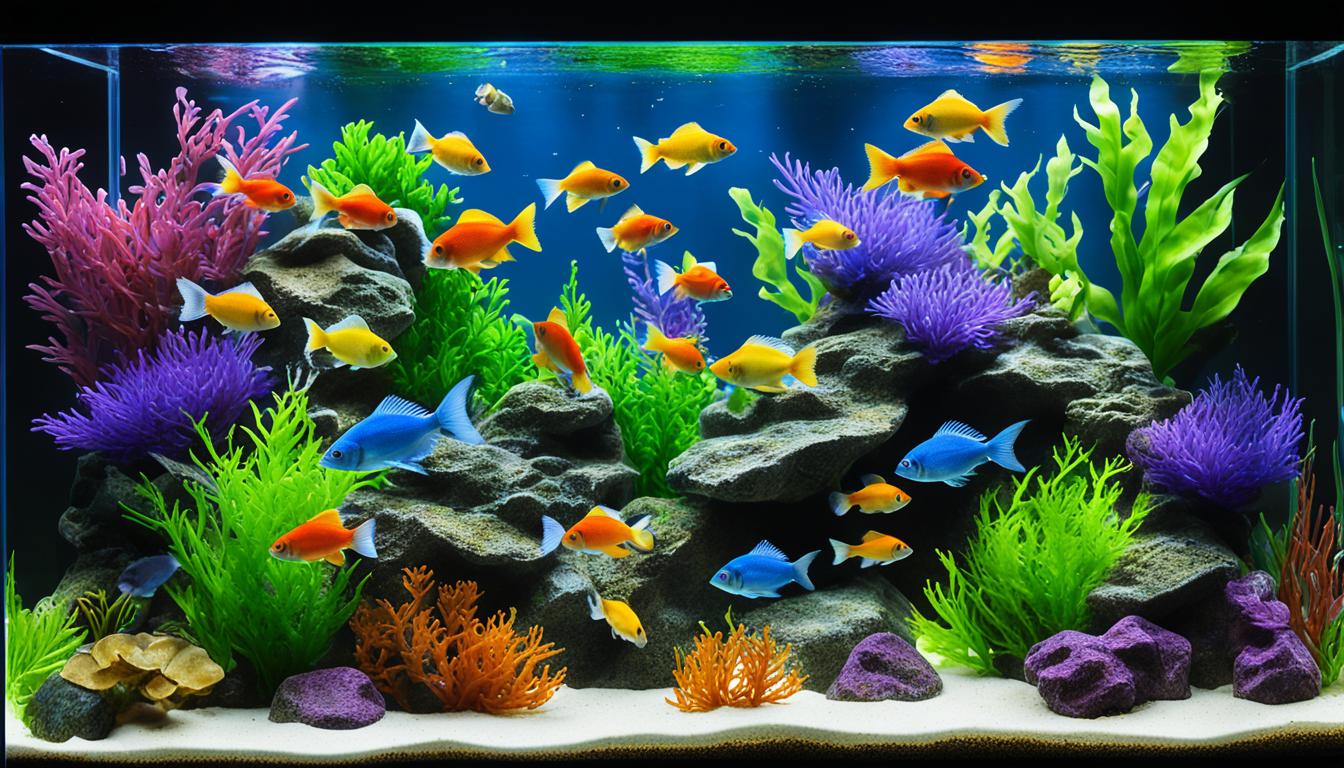Types of Koi Fish: Did you know that there are thousands of different varieties of koi fish? From vibrant colors to intricate patterns, these stunning creatures have captivated the hearts of pond owners around the world. Whether you’re a seasoned koi enthusiast or just starting out, discovering the diverse world of koi fish is sure to leave you in awe.
Join me on a journey as we dive deep into the mesmerizing world of koi fish, exploring the various types, colors, patterns, and descriptions that make each fish unique. By understanding the different varieties available, you’ll be able to create a visually striking and harmonious pond that will be the envy of all who see it.
Table of Contents
Key Takeaways:
- There are thousands of different varieties of koi fish.
- Koi fish come in a wide range of colors and patterns.
- Understanding koi fish types and descriptions is essential for creating a visually stunning pond.
- Selecting the right koi fish for your pond involves considering factors such as size and temperament.
- Proper maintenance and care are crucial for the health and longevity of koi fish.
Understanding Koi Fish Classification
Before exploring the fascinating world of koi fish species, it’s crucial to grasp the concept of koi fish classification. Based on their colors, patterns, and body shapes, koi fish are categorized into various species.
Understanding the classification system allows us to appreciate the distinct characteristics of each koi fish. Let’s dive into the mesmerizing world of koi fish classification.
There are several key factors that contribute to the classification of koi fish:
- Their colors: Koi fish come in a wide range of breathtaking colors, from vibrant reds to serene whites and every shade in between.
- Their patterns: Intricate patterns further enhance the allure of koi fish. These patterns can be spotted, striped, or even marbled.
- Their body shapes: Koi fish possess different body shapes, such as long and slender, robust and stocky, or somewhere in between. Each shape adds a unique touch to their overall appearance.
By carefully analyzing these factors, koi fish enthusiasts and experts can identify specific koi varieties and appreciate their individual beauty.
Now that we have a basic understanding of koi fish classification, we can embark on an exciting journey to explore the mesmerizing varieties and species of koi fish.
Kohaku Koi Fish: The Classic Beauty
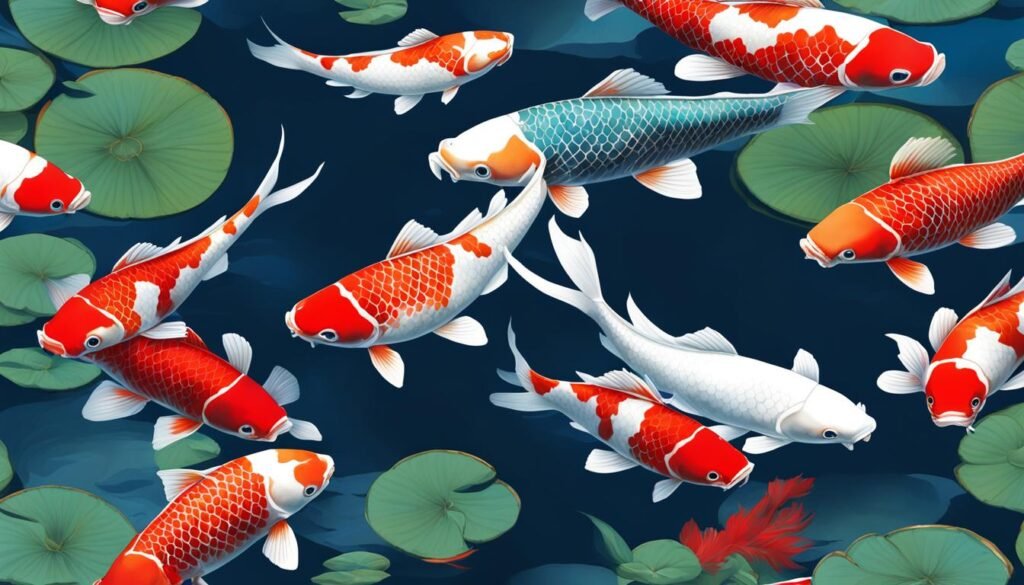
The Kohaku koi fish is truly a classic beauty, cherished by koi enthusiasts around the world.
With its pristine white body and striking red markings, the Kohaku koi showcases an elegant and simple coloration. The contrast between the vibrant red and the pure white creates a visually stunning and captivating display.
This variety of koi fish exemplifies the essence of beauty in its simplicity. The minimalistic color scheme of the Kohaku koi allows the red markings to stand out boldly against the white backdrop, emphasizing their beauty and grace.
Whether gliding gracefully through the water or basking in the sunlight, the Kohaku koi fish exudes an aura of elegance and serenity that is sure to mesmerize any observer.
The image above provides a visual representation of the exquisite Kohaku koi fish, showcasing its pristine white body and vibrant red markings. It serves as a reminder of the visual delight that these classic beauties can bring to any pond.
Quotes:
“The simplicity of the Kohaku koi’s coloration is what makes it truly captivating. It’s a timeless beauty that never fails to impress.” – Koi enthusiast
“The Kohaku koi fish is the epitome of grace and elegance. Its striking red markings against the pristine white body create a harmonious balance that is pleasing to the eye.” – Koi breeder
With its timeless appeal and serene presence, the Kohaku koi fish continues to be a favorite amongst koi enthusiasts and pond owners alike.
Showa Koi Fish: The Majestic Three-Color Beauty
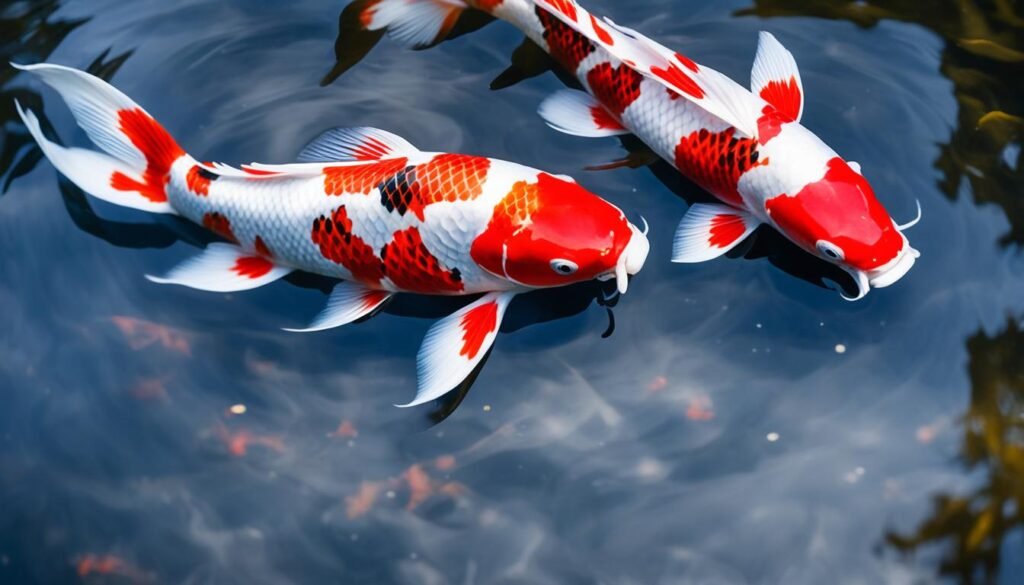
The Showa koi fish is a breathtaking marine creature that captivates koi enthusiasts with its striking black, red, and white coloration. With a three-color pattern that creates a truly dramatic and majestic appearance, the Showa koi is a favorite among pond owners. Its contrasting colors and mesmerizing patterns make it an exquisite addition to any pond or water garden.
The Showa koi fish originated in Japan and is known for its distinct combination of colors. The black pattern, also known as sumi, serves as the primary backdrop for the vibrant red and white markings. The intricate arrangement of these colors creates a visual masterpiece that reflects the exquisite artistry of nature.
The Showa koi has a commanding presence in any pond, drawing attention with its bold and captivating appearance. Its majestic colors and patterns evoke a sense of awe and admiration among those who have the privilege of observing it.
“The Showa koi fish is a true work of art, showcasing nature’s ability to create beauty in the most extraordinary ways.”
To fully appreciate the stunning visual impact of the Showa koi fish, it is best observed in person or through high-quality photographs that capture its essence. The contrast of its black, red, and white colors creates a mesmerizing spectacle that exemplifies the allure and beauty of koi fish.
Showa Koi Fish Characteristics
| Characteristic | Description |
|---|---|
| Color | Black, red, and white |
| Pattern | Black base with red and white markings |
| Body Shape | Various body shapes, including rounded and elongated |
| Size | Can grow up to 36 inches in length |
| Temperament | Calmer compared to some other koi varieties |
Sanke Koi Fish: The Graceful Three-Color Beauty
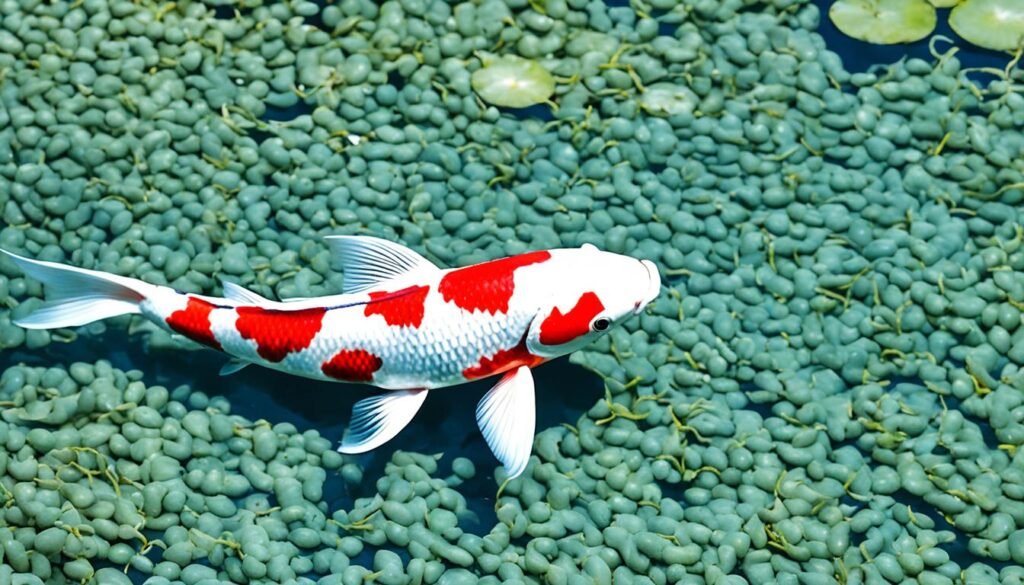
In the world of koi fish, the Sanke koi stands out as a captivating specimen. With its distinctive three-color pattern, the Sanke koi showcases an exquisite combination of white, red, and black markings. The elegance and grace displayed by this variety make it a popular choice among koi enthusiasts.
The Sanke koi fish shares similarities with the Showa koi, both featuring a vibrant three-color scheme. However, what sets the Sanke koi apart is its white body that serves as a canvas for the contrasting red and black patterns. This visually pleasing combination creates a sense of harmony and balance in the appearance of the fish.
Not only does the Sanke koi fish captivate with its intricate pattern, but it also embodies a sense of tranquility and poise. Its presence in a pond can transform the atmosphere, radiating an aura of elegance and serenity.
“The Sanke koi fish is an embodiment of grace and balance. Its white body, adorned with red and black markings, creates a visually striking sight that leaves a lasting impression on any observer.” – Koi Enthusiast
When choosing koi fish for your pond, the Sanke variety offers a unique and mesmerizing addition. Its three-color pattern adds depth and interest to any aquatic environment, creating a visually stunning display that is sure to impress.
Additional Koi Fish Varieties and Colors
In addition to the classic Kohaku, Showa, and Sanke koi fish, there are numerous other varieties and colors to choose from. These varieties offer a diverse range of colors and patterns that can add a unique touch to your pond. Let’s take a closer look at some popular options:
Tancho Koi Fish
The Tancho koi fish is characterized by a single, bold red marking on its head, resembling the Japanese flag. This simple yet striking pattern creates a sense of elegance and beauty.
Ogon Koi Fish
The Ogon koi fish, also known as the “Golden Koi,” features a solid metallic coloration, typically in shades of gold, silver, or platinum. Its shimmering scales reflect light, giving the fish a captivating appearance.
Utsuri Koi Fish
The Utsuri koi fish is recognized for its dramatic black and white or black and red patterns. These contrasting colors create a bold and eye-catching display, making the Utsuri koi a stunning addition to any pond.
These are just a few examples of the many koi fish varieties and colors available. Each variety showcases its own unique beauty, allowing you to create a visually stunning pond that captures the attention of all who see it.
| Koi Fish Variety | Main Color | Distinctive Features |
|---|---|---|
| Tancho Koi Fish | Red | Single red marking on the head |
| Ogon Koi Fish | Gold, silver, or platinum | Metallic scales |
| Utsuri Koi Fish | Black and white, black and red | Contrasting patterns |
With such a wide array of choices, you can select koi fish varieties and colors that suit your personal preferences and create a visually captivating pond. Whether you prefer the simplicity of the Tancho koi, the shimmer of the Ogon koi, or the boldness of the Utsuri koi, each variety brings its own unique charm to your water feature.
Exploring Koi Fish Patterns

Koi fish patterns are a fascinating aspect of their beauty and allure. These intricate patterns add an extra layer of uniqueness and charm to these already stunning creatures. In this section, we will take a closer look at some of the most remarkable koi fish patterns, including the enduring Kohaku pattern and the mesmerizing Asagi pattern.
1. The Kohaku Pattern: One of the most popular and beloved koi fish patterns, the Kohaku pattern features a white body adorned with vibrant red markings. This striking contrast highlights the elegance and simplicity of the Kohaku koi and makes it a true classic in the world of koi fish varieties.
2. The Asagi Pattern: The Asagi pattern is truly mesmerizing, with its silver-blue scales resembling a tranquil sky. The distinct red markings on the back and sides of the fish create a captivating contrast. This pattern is often described as serene and peaceful, adding a sense of depth and tranquility to any pond or water garden.
3. The Kiwa Pattern: The Kiwa pattern is characterized by its unique and intricate edge markings. The edges of the scales are highlighted with colors, which can range from black to red and even orange. This pattern adds a captivating detail to the overall appearance of the koi fish, creating an eye-catching display in any pond.
| Pattern | Description |
|---|---|
| Kohaku Pattern | A white body with vibrant red markings, showcasing elegance and simplicity. |
| Asagi Pattern | Silver-blue scales with distinct red markings, evoking a sense of tranquility. |
| Kiwa Pattern | Edge markings in various colors, adding intricate detail to the overall appearance of the koi fish. |
These are just a few examples of the captivating koi fish patterns that exist. Each pattern is unique and tells a story of its own. Whether you prefer the boldness of the Kohaku pattern or the serene beauty of the Asagi pattern, koi fish patterns offer a wide range of options to suit every preference and taste.
An Overview of Koi Fish Descriptions
When it comes to describing koi fish, there are several key attributes to consider. Understanding these descriptions not only enhances your appreciation for these magnificent creatures but also helps you select the perfect addition to your pond. Let’s explore the different aspects of koi fish descriptions and how each contributes to their overall beauty and value.
Body Shape
Koi fish come in various body shapes, each with its own distinct characteristics. From the long and slender Hikarimono to the robust and rounded Gosanke, the body shape of a koi fish can greatly impact its overall appearance. Whether you prefer a graceful and streamlined shape or a more substantial and balanced form, there is a koi fish body shape that suits your personal taste.
Finnage
The finnage of a koi fish refers to the shape, size, and coloration of its fins. This aspect adds a touch of elegance and movement to the fish, accentuating its beauty. Some koi fish may have long and flowing fins, while others may showcase shorter and more compact finnage. The colors of the fins can range from vibrant reds to delicate whites, complementing the fish’s body and contributing to its overall visual impact.
Scale Quality
The scales of a koi fish play a vital role in its beauty and value. High-quality scales are bright, shiny, and evenly distributed, giving the fish a lustrous and eye-catching appearance. The scales should be free from blemishes, marks, or discoloration, indicating the fish’s health and overall well-being. Koi fish with exceptional scale quality are highly sought after by collectors and enthusiasts.
Understanding different descriptions and characteristics of koi fish helps choose the perfect addition to your pond.
By considering the body shape, finnage, and scale quality when describing koi fish, you can better appreciate their unique attributes and select the ideal fish for your pond. Whether you prefer a sleek and streamlined fish or a more robust and vibrant specimen, koi fish descriptions allow you to make an informed decision based on your preferences and the overall aesthetic you wish to create.
Now that we have explored the various descriptions of koi fish, it’s time to delve into selecting the right koi fish for your pond. In the next section, I will provide some tips and considerations to help you make an informed decision and create a harmonious and visually stunning pond.
Selecting the Right Koi Fish for Your Pond
When it comes to selecting koi fish for your pond, there are a few key factors to consider. By taking the time to evaluate the size, temperament, and compatibility of different koi fish varieties, you can ensure a harmonious and vibrant pond ecosystem.
Size matters
Koi fish come in various sizes, ranging from small to jumbo. It’s important to choose koi fish that are proportionate to the size of your pond. Overcrowding can lead to stress and poor water quality, so aim for a balanced population that allows each fish to thrive.
Temperament and compatibility
Some koi fish varieties are more docile and peaceful, while others are more active and dominant. Consider the overall temperament of your existing fish and choose koi varieties that will get along well with them. Avoid introducing aggressive or territorial fish that may disrupt the harmony of your pond.
Diverse koi fish varieties
Koi fish come in a wide array of colors, patterns, and characteristics. From the vibrant and bold colors of the Kohaku to the striking and dramatic patterns of the Showa, explore the different koi fish varieties to find the ones that resonate with your aesthetic preferences.
Remember to provide adequate space, hiding spots, and clean water conditions for your koi fish to thrive. Regular monitoring of water parameters, such as pH, ammonia, and nitrate levels, will help ensure a healthy environment for your koi fish. By selecting the right koi fish for your pond, you can create a visually stunning and harmonious aquatic haven.
Maintenance and Care for Koi Fish
Keeping koi fish requires proper maintenance and care. As a koi fish enthusiast, it’s essential to prioritize the health and longevity of your beloved aquatic pets. By adhering to a few simple practices, you can ensure that your koi fish thrive in their environment.
Water Quality
One of the fundamental aspects of koi fish care is maintaining optimal water quality. Koi fish are highly sensitive to water conditions, so it’s crucial to test the water regularly for pH levels, ammonia, nitrites, and nitrates. Maintain a healthy balance by regularly monitoring and adjusting these parameters, ensuring a clean and safe habitat for your koi fish.
Feeding
Provide your koi fish with a well-balanced and nutritious diet. High-quality pellets, rich in protein and vitamins, are widely available and formulated specifically for koi fish. Be mindful not to overfeed your fish, as excess food can lead to water contamination and health issues. Feed your koi fish small portions several times a day, and monitor their feeding habits to avoid overconsumption.
Parasite Prevention
Koi fish are susceptible to various parasites, such as flukes, anchor worms, and fish lice. Regularly inspect your fish for signs of parasites, such as excessive flashing or rubbing against objects, visible sores, or unusual behavior. Implement a preventive treatment plan, using specialized medications or natural remedies, to safeguard your koi fish against these pesky intruders.
| Care Tips | Benefits |
|---|---|
| Regularly test and maintain water quality. | Ensures a healthy and safe environment for koi fish. |
| Provide a well-balanced diet with high-quality pellets. | Promotes optimal growth and vibrant coloration. |
| Implement a preventive parasite treatment plan. | Protects koi fish from harmful parasites and enhances overall well-being. |
By prioritizing water quality, proper feeding, and parasite prevention, you can create a thriving environment for your koi fish. Remember to perform regular maintenance tasks such as water changes, filter cleaning, and pond maintenance to ensure the well-being of your aquatic companions.
Conclusion
Exploring the types of koi fish opens up a world of beauty and joy for pond owners. These captivating creatures come in a variety of colors, patterns, and descriptions, allowing you to create a visually stunning pond that mesmerizes all who see it.
From the classic beauty of the Kohaku koi with its white body and vibrant red markings, to the majestic three-color Showa koi fish, and the graceful three-color Sanke koi fish, each variety brings its own unique charm and elegance to your pond.
But it doesn’t stop there. The world of koi fish offers even more options, with varieties like the Tancho, Ogon, and Utsuri koi, each showcasing their own distinct beauty. And let’s not forget the mesmerizing patterns that adorn these fish, from the enduring Kohaku pattern to the captivating Asagi pattern.
By understanding the different types of koi fish, you can make informed choices when selecting the perfect fish for your pond. Whether you’re looking for a specific color, pattern, or body shape, the options are endless. With proper maintenance and care, you can ensure the health and longevity of these magnificent creatures, bringing joy to your pond for years to come.
FAQ
What are the different types of koi fish?
There are various types of koi fish, including Kohaku, Showa, Sanke, Tancho, Ogon, Utsuri, and many more.
How are koi fish classified?
Koi fish are classified based on their colors, patterns, and body shapes.
What is a Kohaku koi fish?
Kohaku koi fish is a popular variety characterized by its white body and vibrant red markings.
What is a Showa koi fish?
Showa koi fish is a majestic variety with striking black, red, and white coloration.
What is a Sanke koi fish?
Sanke koi fish is a graceful variety featuring a white body with red and black markings.
What are some other koi fish varieties and colors?
In addition to Kohaku, Showa, and Sanke, there are various varieties like Tancho, Ogon, and Utsuri, each with its own distinct beauty.
What are the different koi fish patterns?
Koi fish patterns include Kohaku, Asagi, Bekko, and many more, adding uniqueness to their beauty.
How are koi fish described?
Koi fish descriptions involve attributes such as body shape, finnage, and scale quality, all contributing to their overall beauty and value.
How can I select the right koi fish for my pond?
Consider factors like size, temperament, and compatibility with other fish when choosing koi fish for your pond.
What maintenance and care do koi fish require?
Proper maintenance and care for koi fish include monitoring water quality, providing suitable feeding, and preventing parasites for their health and longevity.
References
Aquarium and Tropical Fish Association (ATA)
National Aquarium Society (NAS)
Ornamental Aquatic Trade Association (OATA)
Associated Koi Clubs of America
Koi Organisation International
ZNA Northwest Koi and Goldfish Club
Please check other articles on this website, I have listed some of them here:
Everything You Need to Know About Caring for Blue Zebra Cichlids in Your Aquarium
Everything You Need to Know About Torch Coral: A Stunning Addition to Your Marine Aquarium
The Fascinating Penguin Tetra: Thayeria boehlkei (2023-24)
The Ultimate Guide to Scarlet Badis Care and Breeding
The Ultimate Bamboo Shrimp | Flower Shrimp Guide Which You Dont Want to Miss Out 2023
The Vibrant and Captivating Strawberry Peacock Cichlid: A Guide to Care and Maintenance
Electric Blue Acara: The Ultimate Guide To Care And Keeping
Best Fish for a 40 Gallon Tank: Top Choices for a Thriving Aquarium
Simple Guide to Easy-to-Care-for Aquarium Plants
Discover the Diverse Corydoras Catfish Varieties- A Guide
Get to Know Various Types of Algae Eaters
Master Guide: Best Water Parameters for Goldfish Care 2023-24
Mastering Black Ghost Knife Fish Care: A Comprehensive Guide
Optimal pH Levels for Tropical Fish: Essential Aquarium Guide
Discovering Freshwater Snail Species: An In-depth Guide
Expert Tips for Breeding Guppies: Keys to Successful Fishkeeping
Discover Peaceful Community Fish: Your Guide to Calm Aquatics
Ultimate Guide to Live Food for Betta Fish — Healthy Choices
Complete Guide to Your Perfect Cichlid Tank Setup
Your Guide to the Best Substrate for Planted Aquariums
Essential Guide to Discus Fish Care: Help Your Pets Thrive!
Grow Your Own Eden: Beginner-Friendly Aquascaping Plants Guide
Perfect Neon Tetra Tank Mates: Guide to Aquarium Harmony
Product Review of Eheim Classic vs Professional
The Ultimate Guide to Discus Fish Care
What Fish Can Live With Discus?
Ideal pH for Discus Fish | Aquarium Water Guide
How to Sex Discus Fish?: A Simple Guide for Hobbyists
Complete Discus Fish Tank Setup Guide
Can Discus Fish Live With Angelfish? The Complete Guide
Discus Diet Guide: What Do Discus Fish Eat?
Are Discus Fish Hard to Keep? Insights & Tips.
Optimal Discus Fish Water Parameters Guide
Discus Fish Size Guide 2024: How Big Do Discus Fish Get?
Ultimate Million Fish Guppy Care Guide 2024
Simple Guide to Easy-to-Care-for Aquarium Plants
Grow Your Own Eden: Beginner-Friendly Aquascaping Plants Guide
Hornwort Aquarium Plants: The Ultimate Guide to Care and Maintenance
Aquarium Equipment for Beginners: The Complete Checklist
Feeding Your Aquarium Fish: The Complete Guide
Common Beginner Fishkeeping Mistakes and How to Avoid Them!
Aquarium Plants for Beginners: Easy Care and Beautiful Options
Keeping Your Aquarium Water Clean and Healthy: The Complete Guide
Breeding Aquarium Fish: A Comprehensive Guide
Marine Aquariums: The Ultimate Challenge for Experienced Hobbyists
Tech in the Tank: Must-Have Gadgets for Aquarium Automation
Dwarf Sucking Catfish : The Ultimate Guide to Keeping and Caring for Oto Catfish
The Science of Aquarium Water Chemistry: Understanding pH, KH, and GH
Veiltail Goldfish: The Exquisite Beauty of Flowing Fins
Perfect Neon Tetra Tank Mates: Guide to Aquarium Harmony
Goldfish Care: Beyond the Bowl – Everything You Need to Know
Master Red Tail Shark Care: Tips, Tank Mates & Surprising Traits!
Sheepshead Wrasse Facts & Habitat Guide
Unveiling the Unique Asian Sheepshead Wrasse: A Fascinating Reef Fish with Quirky Behavior
Peacock Wrasse: A Dazzling Addition to Your Aquarium
Vibrant Wrasse Fish: Care Guide & Species Info
Bluestreak Cleaner Wrasse – Vibrant Reef Ally
Coris Wrasse Care Guide for Saltwater Aquariums
Melanurus Wrasse Care Guide & Habitat Tips
The Ultimate Guide to Kuhli Loach
The Ultimate Guide to Popular Loach Species for Freshwater Tanks
Yoyo Loach: The Ultimate Guide to This Fun and Friendly Fish
How to Care for Clown Loaches: The Ultimate Guide for Aquarium Lovers
Optimal Times to Feed Tropical Fish Daily
How to Care for Dojo Loach, the Friendly and Playful Aquarium Fish
How to Care for Zebra Loach: The Ultimate Guide for Beginners
Fu Manchu Lionfish: The Most Beautiful and Mysterious Fish in the Ocean?
The Ultimate Guide to Lionfish Sting: Symptoms, Treatment, and Prevention
Caring for Dwarf Lionfish: Tips & Facts
Hillstream Loach: The Ultimate Guide to Keeping These Unique Fish
The Complete Guide to Platy Fish: Care, Varieties, and Breeding Tips
Endlers Livebearers Care & Breeding Tips
Livebearer Species: The Ultimate Guide
Livebearers vs. Egglayers: Understanding Fish Reproduction
Rosy Barb Care 101: Tank Mates, Size, Breeding, Diet & More
The Complete Oranda Goldfish Care Guide: From Tank Setup, Feeding to Breeding
What Do Koi Fish Eat? Optimal Diet Tips
Koi Fish Lifespan: Facts & Tips Unveiled
Koi Fish Prices: How Much Do Koi Fish Cost?
Unveiling Koi Fish Sizes: How Big Do Koi Fish Get?
I am a passionate aquarist with over 30 years of hands-on experience in fishkeeping. My journey began at a young age, collecting fish from the wild and learning through experimentation. Specializing in tropical fish, I bring a deep understanding of the hobby to FishKeepingMadeSimple. The site provides honest, detailed reviews of essential products and accessories to help fellow enthusiasts create the best environments for their fish.

